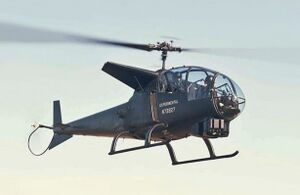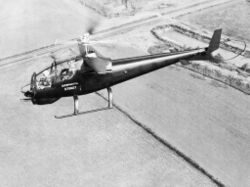Bell 207 Sioux Scout
Topic: Engineering
 From HandWiki - Reading time: 3 min
From HandWiki - Reading time: 3 min
| Bell 207 Sioux Scout | |
|---|---|

| |
| Bell 207 prototype during flight testing | |
| Role | Experimental attack helicopter |
| National origin | United States |
| Manufacturer | Bell Helicopter |
| First flight | 27 June 1963 |
| Number built | 1 |
| Developed from | Bell 47 |
The Bell 207 Sioux Scout is a modified Bell 47 helicopter, developed by Bell Helicopter under contract from the United States Army, as a proof-of-concept demonstrator for the Bell D-255 helicopter gunship design, featuring a tandem cockpit, stub wings, and a chin-mounted gun turret.
Design and development
After several years of development, Bell displayed the mockup of its D-255 "Iroquois Warrior" to Army officials in June 1962, hoping to solicit funding for further development.[1] The D-255 was planned to be a purpose-built attack helicopter based on the UH-1B airframe and dynamic components with a new, slender airframe and a two-seat, tandem cockpit, featuring a grenade launcher in a ball turret on the nose, a 20 mm belly-mounted gun pod, and stub wings for mounting rockets or SS.10 anti-tank missiles.[2]
A proof-of-concept contract was awarded to Bell in December 1962 for the Model 207 Sioux Scout, which was, in essence, a new forward fuselage and Bell 47G-3 dynamic parts fitted to a Bell 47J center and rear fuselage.[3][4][5] The Sioux Scout included all the key features of a modern helicopter gunship – a tandem cockpit, stub wings for weapons, and a chin-mounted gun turret.[3] The tandem cockpit placed the gunner in the lower front seat with the pilot in the rear, with both crew positions featuring flight controls. The gunner's position featured a gunsight and turret controls located in the center, so the flying controls were moved to the side of the front cockpit.[2] The gunner controlled a chin-mounted gun turret with twin 7.62 mm (.308 in) M60 machine guns. The stub wings held external fuel tanks.[6]
First flown on 27 June 1963, the Bell 207 demonstrated improved manoeuvrability over the Bell 47/OH-13, derived from the stub wings. A variety of different wings, cowlings and tail surfaces were tested on the 207 before it was turned over to the Army pilots at Fort Benning, Georgia for further testing at the end of 1963.[2][6][7] After evaluating the Sioux Scout in early 1964, the Army was impressed, but also felt the Sioux Scout was undersized, underpowered, and generally not suited for practical use.[3]
Later in 1964, the Army requested proposals for its Advanced Aerial Fire Support System (AAFSS). Bell proposed the D-262, a smaller version of the D-255, making better use of the T53 engine from the UH-1. However, the Bell D-262 was not selected as a finalist in the competition, which was won by the abortive Lockheed AH-56 Cheyenne.[4]
Specifications
General characteristics
- Crew: Two in tandem cockpits
- Powerplant: 1 × Lycoming TVO-435-A1A 6-cyl. air-cooled horizontally-opposed piston engine, 260 hp (190 kW)
Performance
Armament
- Guns: Two 7.62 mm (.308 in) machine guns in Emerson Electric TAT-101 chin-turret
See also
Related development
- Bell 47
- Bell 47J Ranger
- Bell AH-1 Cobra
Aircraft of comparable role, configuration and era
- Atlas XH-1 Alpha
- Cicaré CH-14 Aguilucho
- IAR 317 Airfox
- HESA Shahed 285
Related lists
- List of military aircraft of the United States
References
- ↑ Goebel, Greg. Cobra Origins . Vectorsite.net, 1 December 2008.
- ↑ 2.0 2.1 2.2 Verier, Mike. Bell AH-1 Cobra, pp. 12–17. Osprey Publishing, 1990. ISBN:0-85045-934-6.
- ↑ 3.0 3.1 3.2 Donald, David and Daniel March. "AH-1 Cobra". Modern Battlefield Warplanes. AIRtime Publishing Inc, 2004. ISBN:1-880588-76-5.
- ↑ 4.0 4.1 Spenser, Jay P. "Bell Helicopter". Whirlybirds, A History of the U.S. Helicopter Pioneers, pp. 268–269. University of Washington Press, 1998. ISBN:0-295-97699-3.
- ↑ Apostolo, Giorgio. "Bell 207 Sioux Scout". The Illustrated Encyclopedia of Helicopters, p. 50. New York: Bonanza Books. 1984. ISBN:978-0-517-43935-7.
- ↑ 6.0 6.1 Pelletier, Alain J. Bell Aircraft Since 1935. US Naval Institute Press, 1992. ISBN:1-55750-056-8.
- ↑ First flight date is listed as late June 1963 in some sources (Pelletier: 27 June, Spenser: late June).
- Verier, Mike. Bell AH-1 Cobra. Osprey Publishing, 1990. ISBN:0-85045-934-6.
External links
- Bulban, Erwin J. Bell Demonstrates New Design for Tactical Helicopter, Aviation Week & Space Technology, September 23, 1963, v. 79, no. 13, pp. 30–32.
 |
 KSF
KSF

